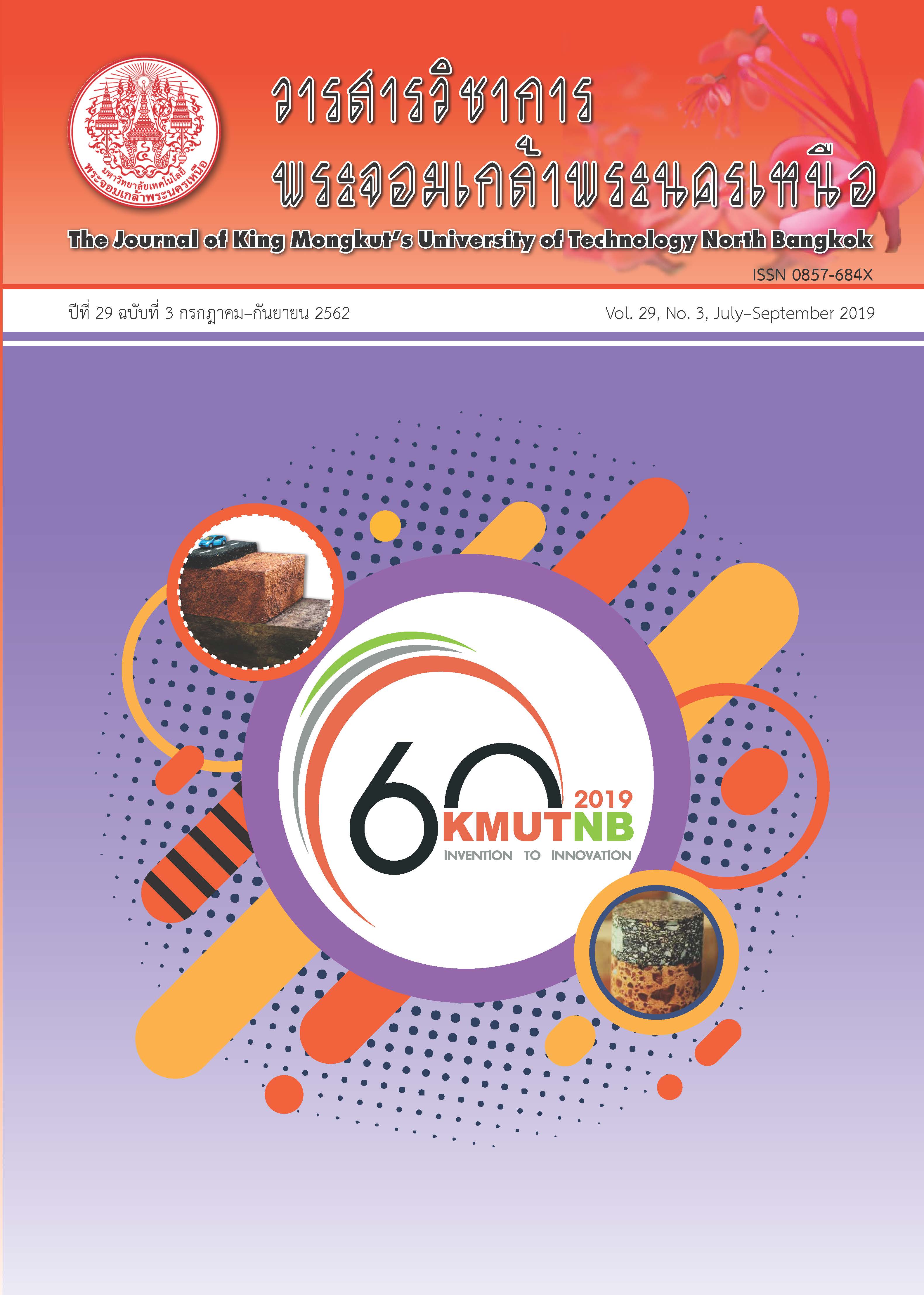การทดสอบหาสมบัติทางกลของเหล็กกล้าคาร์บอนต่ำด้วยการทดสอบแบบเป่าโป่งด้วยน้ำเพื่อนำไปใช้กับการจำลองของกระบวนการลากขึ้นรูปโลหะแผ่นด้วยน้ำ
Main Article Content
บทคัดย่อ
งานวิจัยนี้นำเสนอแนวทางของการหาค่าความสัมพันธ์ระหว่างความเค้นและความเครียดของโลหะแผ่นเหล็กกล้าคาร์บอนต่ำ SPCC ความหนา 1 มม. วัตถุประสงค์เพื่อนำผลจำลองการขึ้นรูปด้วยสมบัติจากการทดสอบแบบเป่าโป่งด้วยน้ำนำไปสู่การนำไปใช้ในการลากขึ้นรูปด้วยน้ำ โดยได้ทำการเปรียบเทียบค่าความสัมพันธ์ระหว่างความเค้นและความเครียดที่ได้จาก 2 การทดสอบ ได้แก่ 1) การทดสอบแรงดึงแกนเดียวตามมาตรฐาน ASTM E8/E8M-09 และ E646-16 มีค่าเท่ากับ 512.29 ค่าเท่ากับ 0.159 และมีค่า r-Lankford ตามมาตรฐาน ASTM E517-00 เท่ากับ 1.29 และ 2) การทดสอบแบบเป่าโป่งด้วยน้ำ เป็นการทดสอบขึ้นรูปในสภาวะแรงดึงสองทิศทาง (Biaxial) โดยได้ทำการพิสูจน์แม่พิมพ์จากงานวิจัยของสุวัฒน์ แล้วพบว่ามีสภาวะการขึ้นรูปเป็นไปตามทฤษฎีแผ่นบาง (Membrane) ทำให้การใช้ข้อมูลทดสอบที่ได้จากแม่พิมพ์นี้มีความน่าเชื่อถือ จากนั้นทำการทดสอบแบบเป่าโป่งด้วยน้ำและวัดค่าพารามิเตอร์ต่างๆ เพื่อหาค่าความเค้นและความเครียดประสิทธิผล พบว่ามีค่าระดับความเครียดประมาณ 0.85 แต่การทดสอบแรงดึงแกนเดียวสามารถให้ช่วงความเครียดเพียง 0.3 เท่านั้น ซึ่งสอดคล้องกับการทบทวนวรรณกรรมต่างๆ แต่เมื่อหาความเข้ากันของสมการกฎยกกำลัง พบว่า การทดสอบแบบเป่าโป่งด้วยน้ำของเหล็กกล้าคาร์บอนต่ำนี้แสดงอิทธิพลคุณสมบัติความไม่เท่ากันทุกทิศทาง ทำให้ค่าความเค้นมีค่าสูงมากต้องทำการลดอิทธิพลค่า r-Lankford ออก แต่เนื่องจากยังไม่สามารถทำการหาค่า r-Lankford จากการทดสอบแบบเป่าโป่งด้วยน้ำได้ จึงต้องใช้ค่า r-Lankford ที่ได้จากการทดสอบแรงดึงแกนเดียวมาทำการลดอิทธิพลค่าดังกล่าวแทนได้ค่า K และ n เท่ากับ 665.04 และ 0.3007 โดยจะนำเอาค่าพารามิเตอร์ที่ได้จากทั้ง 2 การทดสอบ มาจำลองการขึ้นรูปชิ้นงานพาราโบลิกผ่านระเบียบวิธีไฟไนต์เอลิเมนต์ เปรียบเทียบกับการขึ้นรูปชิ้นงานพาราโบลิกจริง พบว่า ลักษณะชิ้นงานพาราโบลิกที่มีการกระจายความหนาบริเวณผนังชิ้นงานใกล้เคียงสอดคล้องกับการทดสอบขึ้นรูปจริงที่มีค่าประมาณ 0.755 มม. มากที่สุดคือผลจากการจำลองการขึ้นรูปด้วยสมบัติทางกลที่ได้จากการทดสอบแบบเป่าโป่งด้วยน้ำ ที่มีค่าการกระจายความหนาบริเวณผนังชิ้นงานประมาณ 0.759 มม. แต่ผลจำลองการขึ้นรูปที่ได้การทดสอบแบบแรงดึงแกนเดียวนั้นมีค่าการกระจายความหนาบริเวณผนังชิ้นงานประมาณ 0.605 มม. ซึ่งต่างจากผลการทดสอบขึ้นรูปจริง 0.15 มม.
Article Details
บทความที่ลงตีพิมพ์เป็นข้อคิดเห็นของผู้เขียนเท่านั้น
ผู้เขียนจะต้องเป็นผู้รับผิดชอบต่อผลทางกฎหมายใดๆ ที่อาจเกิดขึ้นจากบทความนั้น
References
[2] ASTM International, Standard Test Methods for Tension Tesing of Metallic Materials: E8/E8M-11, 2010.
[3] K. Wiratchakul, “The reliability analysis of parabolic part quality from uncertainty of sheet metal properties,” M.S. thesis, Department of Industrial Engineering, Faculty of Engineering, King Mongkut’s University of Technology North Bangkok, 2011 (in Thai).
[4] ASTM International, Standard Test Methods for Tensile Strain-Hardening Exponents (n-Values) of Metallic Sheet Materials: E646-16, 2017.
[5] ASTM International, Standard Test Methods for Plastic Strain Ratio r for Sheet Metal: E517-00, 2010.
[6] C. Thanadngan, Metals Forming Technology, Bangkok: KMUTNB Textbook Publishing Center, 2004 (in Thai).
[7] G. Gutscher “Evaluation of formability and determination of flow stress curve of sheet metals with hydraulic bulge test,” Degree of Diploma Engineering, The Institute for Metal Forming Technology, The University of Stuttgart in collaboration with the Engineering Research Center for Net Shape Manufacturing, The Ohio State University, Columbus, Ohio State, 2000.
[8] C. Udomraksasakul, “Correction assessment of flow stress curve from hydraulic bulge test,” M.S. thesis, Department of Industrial Engineering, Faculty of Engineering, King Mongkut’s University of Technology North Bangkok, 2011 (in Thai).
[9] S. Jirathearanat, “Research and development,” MTEC, Klonglung, Pathumthani, Annual Report, 2009 (in Thai).
[10] M. Koc, E. Billur, and Ö. N. Cora, “An experimental study on the comparative assessment of hydaulic bulge test analysis methods,” Material and Design, vol.32, no. 1, pp. 272–281, 2011.
[11] C. Udomraksasakul, T. Intarakumthornchai, and S. Jirathearanat, “A study of strain condition on deformed part in hydraulic bulge test,” in Proceedings OR-NET, National Operation Research Network Conference, 2011, pp. 376–382 (in Thai).
[12] C. Boonjaeng, “Evaluation of flow stress curve from hydraulic bulge test,” M.S. thesis, Department of Industrial Engineering, Faculty of Engineering, King Mongkut’s University of Technology North Bangkok, 2012 (in Thai).
[13] G. Gutscher, H. Wu, G. Ngaile, and T. Altan, “Determination of formability and flow stress curve for sheet metals using the viscous pressure bulging (VPB) test.” Journal of Materials Processing Technology, vol. 146, no. 1, pp. 1–7, 2004.
[14] T. Intarakumthornchai, “An experiment study on the assessment of hydraulic bulge test,” STRI of KMUTNB, Bang Sue, Bangkok, July. 2011 (in Thai).
[15] T. Intarakumthornchai, “Strategies for blank holder force and pressure design through FEA simulation in sheet hydroforming,” Ph.D. dissertation, Department of Industrial Engineering, Faculty of Engineering, Chulalongkorn University, 2009.
[16] T. Intarakumthornchai and S. Jirathearanat, “Sheet hydroforming technology for automotive part cluster,” in Proceedings CIOD, the 2nd Conference of Industrial Operation Development, 2011, pp. 1–8 (in Thai).
[17] S. Suriyan, “Investigation of parabolic part forming with hydromechanical deep drawing process,” M.S. thesis, Department of Industrial Engineering, Faculty of Engineering, King Mongkut’s University of Technology North Bangkok, 2011 (in Thai).
